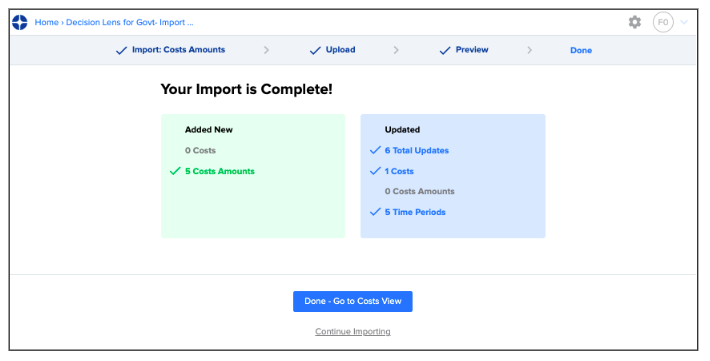Overview:
Portfolio Owners can use the import option to add or update Projects, Project Fields, Budgets, Budget Fields, Cost Amounts and Budget Amounts within the Baseline Plan.
Setup Your Data for Importing
If your portfolio does not have any data, select the “Import Spreadsheet” option from any portfolio page. If your portfolio has some data, select the Actions menu from Projects, Budgets or Schedule and select “Import”.
On the first step of import, select the “Decision Lens Import Template.xlsx” link at the bottom of the screen for tips and templates to show how data should be setup in Excel for a successful import.
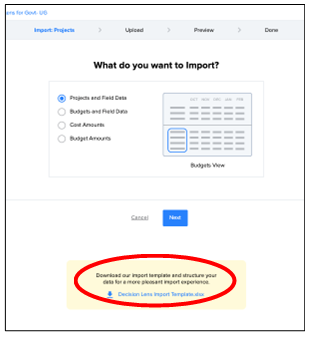
Import Projects and Field Data
After setting up your spreadsheet, select the option to add “Projects and Field Data” from the first step of import and select “Next”.
Follow the steps in the Upload step to select your .xls file, the sheet where your data is, and the column Project Names are in. Decision Lens will try to select the Project Name column automatically. If the column automatically selected is incorrect, use the dropdown to select the right column. Select Next.
If your project data needs to be imported based off a field other than project name, such as a unique identifier, select the checkbox to 'Use a column other than Project as a Project Identifier'. You can then select the column in the spreadsheet that should be used to identify projects.

On the Preview Step, review the data about to be imported to ensure the number of projects and fields that will be added and updated is correct.
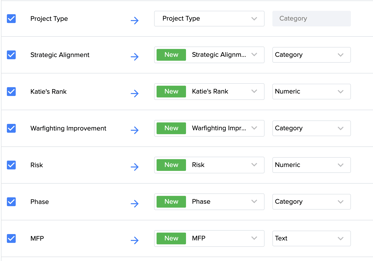
- Use the checkbox beside each field to exclude certain fields from being imported. New fields will be indicated with a “New” label.
- In the Projects Field column, check to make sure each field from Excel is being imported into the correct field in Decision Lens, or being created as a New field.
- If needed, modify the data type for new fields. Decision Lens attempts to map the data in your spreadsheet to the correct data type within a portfolio but if our predictions are not correct, you can modify the data type prior to importing your data.
- Review any warnings noted in the Errors and Notifications column.
- Select “Start Import” once you are done with your review.
Once the import has completed, you will see a confirmation to inform the total number of Projects and Fields added and total number of Updates to Existing Projects.
Note: At this time, Status, Start Date and End Date cannot be imported for Projects. Duplicate Project Names can also not be imported and the last record within the sheet will be the only one imported or used for updates.
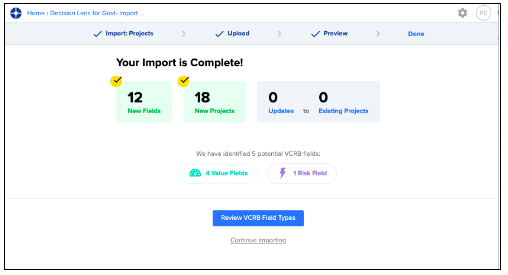
To import more data, select “Continue Importing”. To review the fields imported and adjust field mapping, select “Review VCRB Field Types”. Decision Lens uses a framework for fields to categorize them into areas of Value, Cost, Risk or Balance. This helps when using capabilities like Strategy Navigator or Bottleneck Analysis during Scenario Planning. During import, Decision Lens categorizes your fields for you and then let’s you review them on the VCRB Framework Page to adjust if necessary.
Import Budgets and Field Data
If you have multiple Budgets and/or Budget Fields, use import to make bulk additions or updates.
From the first step of import, select “Budgets and Field Data” and select “Next”. Upload your .xls file, select the sheet containing the data to import and confirm the column containing your Budget Names in your Excel sheet was correctly selected by Decision Lens. Select “Next”.
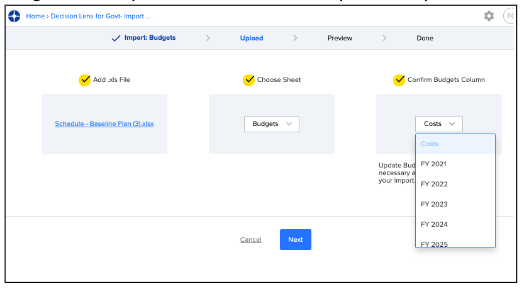
The Preview step allows you to see the count of Budget Fields, Budgets, and count of Updates to Existing Budgets that will be completed. Select “Start Import” to begin importing the data.
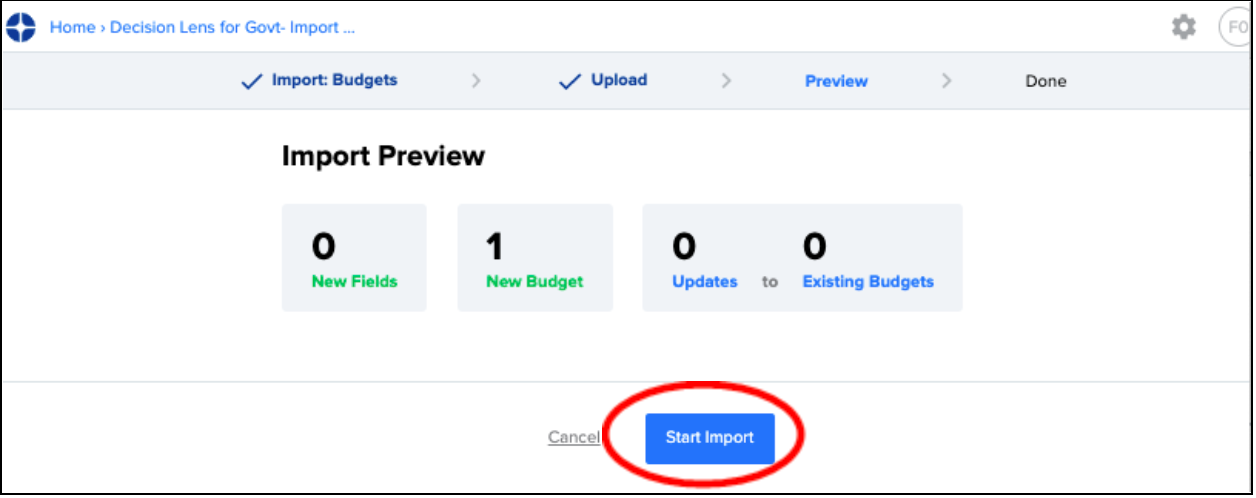
When the import is complete, a confirmation displays with the options of “Continue Importing” or “Manage Costs”. “Go to Manage Costs” takes you to the Manage Budgets page to review the data just imported and modify if necessary.
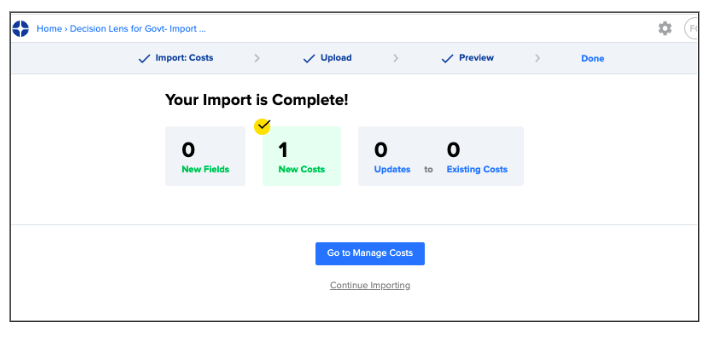
Import Cost Amounts
The Cost Import populates the Cost data for projects which could include multi-time period and multi-Cost Type data. There are 4 types of Cost Import that can be done: Request, Allocated, Planned Spend and Obligations.
Note: To import Planned Spend and Obligation data, the Spend Plan view must be enabled.
From the first step of import, select to import Cost Amounts and then select the cost type. Select the “Next” button.
In the Upload step, add your.xls file, select the sheet containing the data to be imported, and confirm your Project Names and Cost Field column.
Note: We recommend looking at the Cost Import Templates that can be downloaded on the first step of import. The Cost Import needs to be setup in a specific way to ensure all data can be properly mapped to Projects, Cost Fields, and Time Periods.
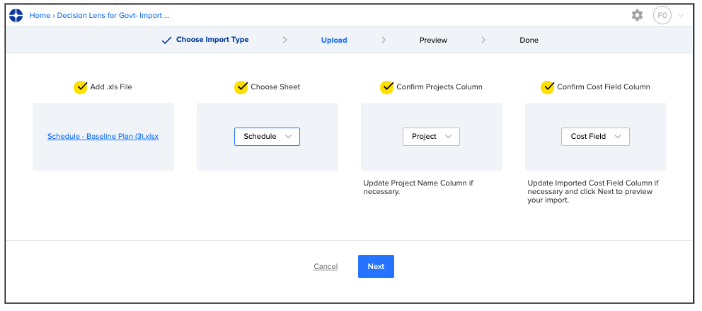
Select “Next” to preview the counts of data that will be imported. Import Preview will inform total counts of new Projects and Cost Fields that will be added and counts for the total updates, projects and cost fields being updated.
Selecting to “Start Import” will add any new Projects and Costs and update Costs for Projects that already exist.
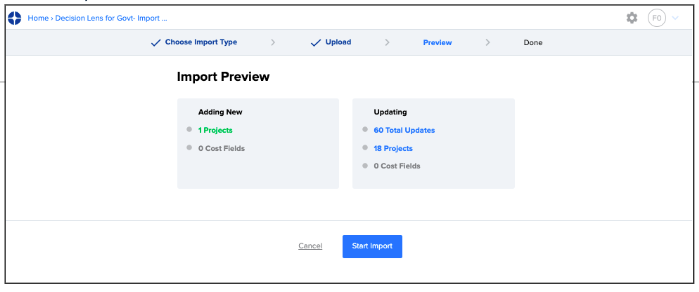
Once the import is complete, a confirmation displays to inform counts of data imported with the options to continue importing, review field mappings on the VCRB Framework Page or go to view the schedule on the Budgets Page.
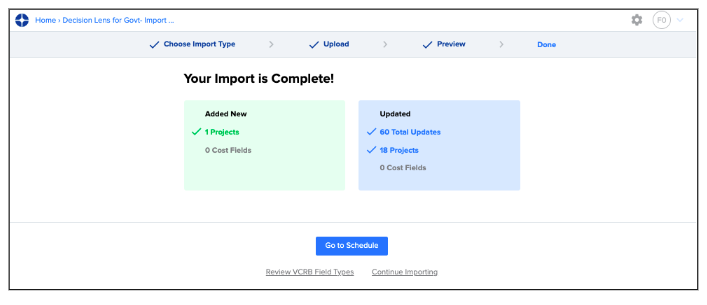
Import Budget Amounts
For portfolios with many Budgets, import can be helpful too quickly add or modify Budgets or Budget amounts. On the first step of import, select “Budget Amounts”. This will populate the top of the Budgets Page. Select “Next”.
On the Upload step, add your .xls file, select the sheet containing the budget amounts and confirm the column containing budget names has been correctly mapped. Select “Next” to preview the counts of data that will be imported.
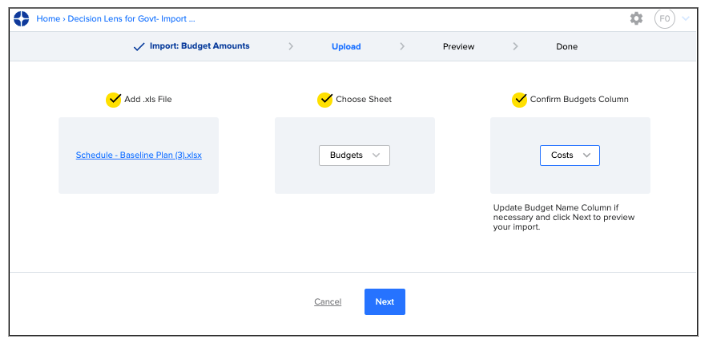
The Preview step shows total counts for how many new budgets and budget amounts will be imported. It also highlights total updates for budgets, budget amounts and time periods. Select “Start Import” to add or update budget amounts in your portfolio.
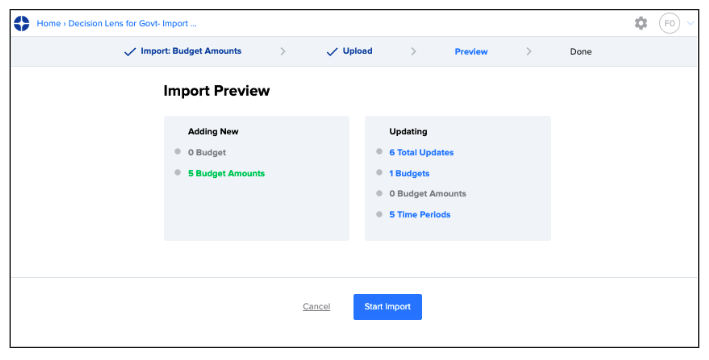
When import is complete, a confirmation displays to confirm counts of data imported. Use the “Continue Importing” option to import more data or select the Done button to go to the Budgets Page to view the data imported.
